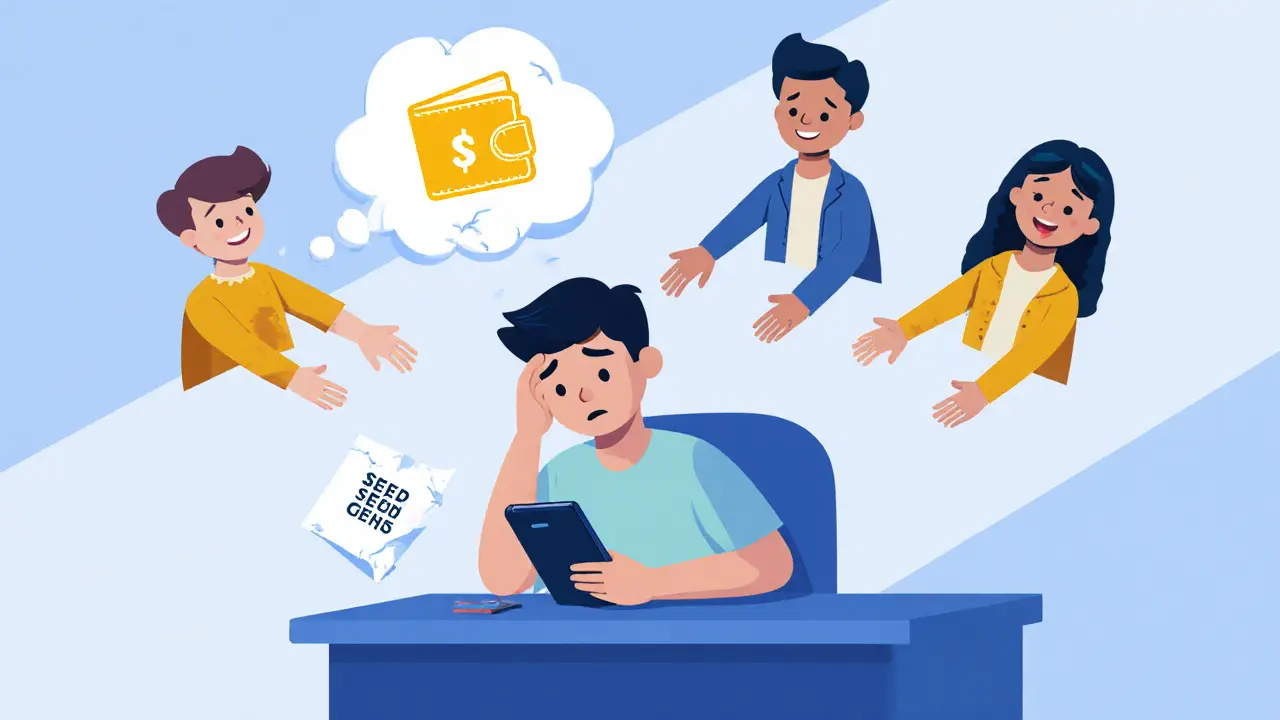Social Recovery Configuration Tool
Configure Your Social Recovery
Recovery Analysis
Security Assessment
Moderate Security
Balanced protection against accidental loss and malicious attacks.
Risk Analysis
Potential Risk: Guardians may be unavailable or unresponsive. Mitigation: Add backup guardians and use multi-channel verification.
Recommended Wallets
Best Practices
- Use guardians with strong security practices (hardware wallets + 2FA)
- Verify guardians through multiple channels (email, SMS, QR)
- Keep backup guardian list in a secure location
- Run recovery simulations before emergency situations
Crypto users keep hearing about lost keys and the headaches of seed phrases. What if you could regain access to a wallet without memorizing a 12‑word string, simply by contacting a few trusted friends? That’s the promise of social recovery powered by account abstraction - a design shift that moves control from cryptographic keys to programmable smart contracts.
What is Account Abstraction?
Account abstraction replaces the classic externally owned account (EOA) - a public‑private key pair - with a Account Abstraction is a mechanism that separates fund control from transaction execution, allowing smart‑contract wallets to define custom logic for every operation. The Ethereum upgrade known as ERC‑4337 (introduced in 2021 and live on mainnet since March 2023) provides the full infrastructure: UserOperations, bundlers, an EntryPoint contract, and optional paymasters that cover gas fees.
How Social Recovery Works Inside a Smart‑Contract Wallet
Social recovery is built directly into the contract that governs a wallet. Instead of a single private key, the wallet stores a list of "guardians" - real people or institutions you trust. The recovery process typically follows an M‑of‑N rule: for example, any two out of three guardians can approve a recovery transaction after a timelock.
A typical flow looks like this:
- User loses access to the device holding the wallet.
- They submit a recovery request via the wallet UI.
- Guardians receive a notification (Telegram, email, or push).
- At least the required number of guardians sign the request with their own wallets.
- The smart contract verifies the signatures, checks the timelock, and migrates ownership to a new address the user controls.
The entire process runs on‑chain as a single UserOperation, so no centralized server can intercept or alter it.
Why Social Recovery Beats Traditional Seed Phrases
Studies show that 78% of crypto newcomers cite seed‑phrase management as their biggest security worry. Lost or poorly stored phrases leave roughly 20% of Bitcoin worth billions inaccessible. Social recovery eliminates that single point of failure. Instead of a paper note or a hidden file, the safety net becomes a network of people you already trust.
Compared to custodial services, social recovery retains self‑custody - the funds never leave your control, but you gain a fallback mechanism that protects against loss, theft, or device failure.

Risks and How to Mitigate Them
Moving trust to guardians introduces new attack vectors. Social engineering can target recovery contacts, and a delayed timelock (12‑72hours) means funds are temporarily frozen during emergencies. Mitigation strategies include:
- Choosing guardians with strong security hygiene (use of 2FA, hardware wallets).
- Setting a reasonable M‑of‑N threshold - 2‑of‑3 is common, balancing security and availability.
- Adding backup guardian tiers to cover inactive contacts.
- Using reputable wallet providers that audit their recovery code (e.g., Argent is a smart‑contract wallet that pioneered 2‑of‑3 social recovery with time‑locked approvals).
Leading Wallet Implementations
Several wallets have baked social recovery into their core:
| Wallet | Guardians Required | Timelock Range | Gas Overhead | Supported Networks |
|---|---|---|---|---|
| Argent | 2‑of‑3 | 24‑72hrs | ~20% higher than simple transfer | Ethereum, Polygon |
| Safe | 3‑of‑5 (configurable) | 12‑168hrs | ~15% higher | Ethereum, Gnosis Chain, BNB Smart Chain |
| Starknet | 2‑of‑3 | 12‑168hrs | 5‑10% higher (Layer‑2) | Starknet (Layer‑2) |
| Stackup | 2‑of‑4 | 48‑96hrs | ~18% higher | Ethereum (via bundlers) |
All four solutions rely on the ERC‑4337 framework, which means they share the same underlying security assumptions about bundlers and the EntryPoint contract.
Step‑by‑Step: Setting Up Social Recovery
Even if you’re not a developer, the setup takes about ten minutes. Here’s a practical checklist:
- Download a wallet that supports account abstraction (e.g., Argent, Safe).
- Create a new smart‑contract wallet; the app will generate a wallet address for you.
- Navigate to the “Recovery” or “Guardians” section.
- Select 3‑5 contacts you trust. Provide their wallet addresses or ENS names.
- Verify each guardian via a secondary channel (email, SMS, or in‑app QR code).
- Choose the M‑of‑N threshold (most users pick 2‑of‑3).
- Set a timelock length that balances safety and convenience.
- Run a dry‑run recovery simulation - the wallet will walk you through the process without moving funds.
After the simulation, write down the emergency contact list in a secure place (e.g., encrypted note). That’s all you need to feel confident that losing a phone won’t lock you out forever.

Future Directions: Biometric, Cross‑Chain, and AI‑Assisted Recovery
Research labs and wallet teams are already extending the concept. Authereum plans to add fingerprint or facial recognition as a secondary factor to confirm a guardian’s approval. Squads.so is building a cross‑chain bridge that lets an Ethereum guardian recover a Solana wallet, unifying assets under a single social network. Consensys labs have a prototype that uses AI to verify a guardian’s identity by analyzing voice or video signatures, cutting down the social‑engineering risk.
Regulators are catching up, too. Europe’s MiCA framework may require KYC for any guardian who can recover accounts holding more than €1,000, which could push wallet providers to integrate verified ID services.
Bottom Line: Is Social Recovery Right for You?
If you’re an early adopter who already manages private keys, adding a social layer adds a safety net with modest extra gas costs. For newcomers, the feature can be the difference between walking away from crypto or staying engaged. The technology isn’t flawless - it needs reliable guardians and a willingness to wait out a timelock - but the trade‑offs are far better than holding a piece of paper that could be lost forever.
Frequently Asked Questions
What is the main advantage of social recovery over a seed phrase?
A seed phrase is a single point of failure - lose it, lose access. Social recovery distributes the trust across multiple real‑world contacts, so losing a device doesn’t mean losing funds.
Do I still need to back up my seed phrase?
Yes. The underlying smart‑contract wallet still uses a private key to sign transactions. The seed phrase is your emergency fallback if all guardians become unavailable.
How long does a recovery take?
Most implementations enforce a timelock of 12‑72hours. The delay prevents instant theft if a guardian’s account is compromised.
Can I use social recovery on any blockchain?
Currently it works on Ethereum‑compatible chains that support ERC‑4337 or similar account‑abstraction standards. Emerging projects on Solana and Polygon are adding compatible layers.
What happens if my guardians refuse to help?
If the required number of guardians does not respond, the recovery cannot complete. That’s why a backup tier or a slightly larger guardian set is recommended.

Bobby Lind
August 5, 2025 AT 13:21Wow, this is super interesting!!! Social recovery could really save a lot of people from losing their crypto!!
Jessica Cadis
August 6, 2025 AT 13:14Look, the idea sounds good on paper, but it’s a massive attack surface waiting to be exploited. If your guardians get phished, you lose everything – end of story.
Katharine Sipio
August 7, 2025 AT 13:07I think the social‑recovery model is a promising step forward. By distributing trust among reliable contacts, users gain a safety net without sacrificing self‑custody. It’s a pragmatic solution for newcomers.
Shikhar Shukla
August 8, 2025 AT 13:01While the concept is theoretically sound, the practical implementation raises concerns. The reliance on external guardians introduces a human factor that is notoriously unreliable. Moreover, the timelock, though intended as a safeguard, can be a critical inconvenience during urgent situations.
Deepak Kumar
August 9, 2025 AT 12:54Alright folks, let’s break this down step by step. First off, account abstraction is a game‑changer because it lets us replace the single private‑key model with programmable logic. That means we can embed recovery rules directly into the wallet contract, no more fumbling with paper seed phrases. 🎉
Second, the M‑of‑N guardian system spreads trust-if you pick three friends and require two approvals, you get both security and accessibility. It’s like having a multi‑signature safe where the vault only opens when a quorum says “yes.”
Third, the timelock isn’t just a delay; it’s a protective window that thwarts instant theft if a guardian’s account gets compromised. During that window, you can still cancel the recovery if you notice something fishy. 🕒
Fourth, the gas overhead is modest-about 15‑20% extra compared to a regular transfer-so you’re not burning a hole in your pocket for peace of mind.
Fifth, setting it up is literally a ten‑minute process: download a compatible wallet like Argent or Safe, add your guardians, verify them, and run a dry‑run. Even if you’re not a developer, the UI walks you through every step.
Sixth, remember to choose guardians who practice good security hygiene-hardware wallets, 2FA, secure emails. The human element is the weakest link, so reinforce it with strong habits.
Seventh, consider a backup tier of guardians in case your primary contacts become inactive. Redundancy is the name of the game.
Eighth, keep an encrypted note of the guardian list and your seed phrase as a last‑resort fallback.
Ninth, stay aware of future developments: biometric layers, cross‑chain recovery, even AI‑assisted identity checks are on the horizon. The ecosystem is evolving fast.
Tenth, regulatory trends like Europe’s MiCA might soon require KYC for guardians handling sizable assets, so be prepared for that shift.
Eleventh, always test the recovery flow before you actually need it. A dry‑run can reveal UI quirks or guardian availability issues.
Twelfth, think about the social dynamics-choose people you trust and who understand the responsibility.
Thirteenth, if you ever lose access to all guardians, the seed phrase is still your emergency key, so don’t discard it.
Fourteenth, community feedback is vital-share your experiences, suggest improvements, and help harden the protocol.
Fifteenth, enjoy the peace of mind that comes with knowing you have a safety net without surrendering control. Social recovery is not flawless, but it’s a massive upgrade from a single piece of paper that could vanish tomorrow.
Happy securing! 🚀
Matthew Theuma
August 10, 2025 AT 12:47Interesting read-social recovery feels like the philosophical answer to the problem of lost keys. It’s as if we’re embedding trust networks directly into code, turning what was once a purely technical issue into a social one. 🤔
Just remember, the chain is only as strong as its weakest link, whether that’s a careless guardian or a bug in the contract.
Carolyn Pritchett
August 11, 2025 AT 12:41This is just another marketing gimmick.
Sara Stewart
August 12, 2025 AT 12:34From an engineering standpoint, integrating social recovery into ERC‑4337 is a slick move; the modularity lets developers plug in custom guard logic without overhauling the entire wallet stack. Plus, the gas‑cost trade‑off is acceptable for the added security layer.
Schuyler Whetstone
August 13, 2025 AT 12:27Honestly, if you can’t keep track of three friends’ wallets, maybe crypto isn’t for you. Stop blaming the tech and start taking responsibility.
Vinoth Raja
August 14, 2025 AT 12:21It’s fascinating how the shift from a single private key to a distributed guardian model mirrors concepts in distributed consensus-both aim to mitigate single‑point failures through redundancy. Yet, the human factor remains the wild variable.
Ikenna Okonkwo
August 15, 2025 AT 12:14Great overview! Social recovery really brings a balance between self‑custody and safety. If you pick trustworthy guardians and set a reasonable timelock, you’ll have a solid backup plan without giving up control.
Cecilia Cecilia
August 16, 2025 AT 12:07I appreciate the thorough explanation. The practical steps are clear and concise.